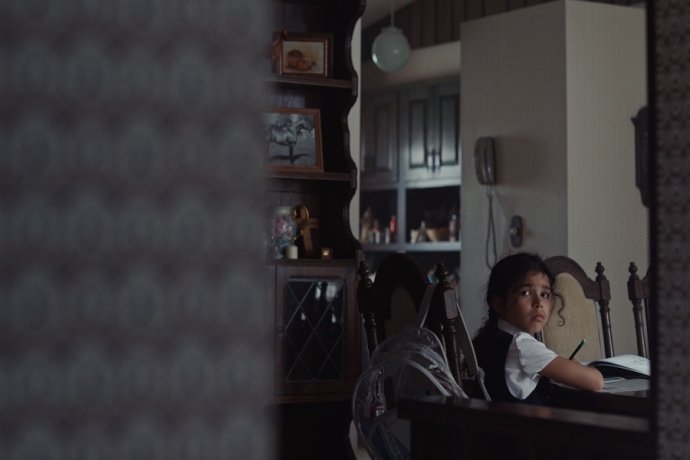HCAF ’24: BORDERS | NO BORDERS, Narrative Shorts
BORDERS|NO BORDERS is the short film competition hosted by Houston Cinema Arts Society for stories focused on Texas and its neighboring regions. Hyperreal Film Journal watched the six narrative short film finalists as part of our coverage of the Houston Cinema Arts Festival 2024.
This year’s selection saw a natural theme emerging as it progressed, with a focus on youth and precarious futures. These finalist films told stories that grappled with the unknown things to come, while centralizing subjects who were doing their best to make peace with the past and sometimes build better futures, as competition programmer Michael Robinson put it at the event.
The competition included one bracket for narrative short films and another for documentary short films, with each bracket culminating in a recognition for Best Picture and a recognition for Jury Prize. We'll solely focus on the finalists for the narrative short film bracket, however it’s important to note all four winners from this year's competition.
Best Picture, Narrative Shorts: “Jedo’s Dead” (dir. Sara Nimeh)
Jury Prize, Narrative Shorts: “Sweatshop Girl” (dir. Selma Cervantes)
Best Picture, Documentary Shorts: “Wild Hogs and Saffron” (dir. Andy Sarjahani)
Jury Prize, Documentary Shorts: “Sangre Violenta/Sangre Violeta” (dir. Edna Diaz, Arturo Jimenez)
“Sweatshop Girl (Chica de Fábrica)”
The finalist short opened with a powerful, evocative story about a woman working in a sweatshop. Implied context abound, she sits as the lady behind her begins taunting her. Is she her rival? We realize later when they’re catching lunch together that it was just teasing—she’s her friend. The story implies her dynamics with the security guard and the boss of the sweatshop as well through momentary interactions with other characters. This sort of efficient storytelling can only result from direction that is crystal clear in its vision. In a sixteen-minute period of time we become privy to about five different interweaving character relationships.
Still, the story never loses focus from its main character, Inés, played by Yaritza Aparicio. She’s newly pregnant and this could jeopardize her ability to work. Director Selma Cervantes showcases a mastery of tone here; we feel her protagonist’s dread before we know what it’s about. In this regard Aparicio also deserves mounds of praise for her heart wrenching performance. This anxious, threatened tone enhances the story’s point regarding the cruelty of a system that punishes something as natural and necessary as childbirth. If you don’t trust that you can have a child without taking a catastrophic hit to your livelihood, what does it say about your society? This is an important question to ask for anyone living anywhere in the world. This film’s most significant accomplishment is its ability to tell a story about a particular situation, make you feel something strongly, and render from it something broadly telling.
“Jedo’s Dead”
This story layers on characters and their dynamics as we move through a child’s raw, innocent grieving process. A little girl comes home from school and finds her grandfather in bed, not moving. We realize he’s dead as she does. She moves through the house encountering different objects and as they trigger memories of him, we see them with her. A spoon that reminds her of the yogurt he liked to eat, sometimes stuck in his moustache. A record player she would dance to as he ate yogurt. We also learn from symbols placed throughout the house that these children were part of a Maronite family living in America, which adds a layer of personal significance from Lebanese filmmaker, Sara Nimeh. When the little girl’s brother comes home the two react like children in the purest way. They call mom, who’s working and unable to pick up. They confront raw undefined emotions when the older brother freaks out. They call 9-1-1 and change their minds. They wear Jedo’s clothes and sit with him. They distract themselves with homework.
This child’s emotional journey, having been trapped in a house with her grandfather’s body, serves as an evocative meditation on innocence and death. In this story the absence of what was is felt as strongly as the presence of what is.
“Los Mosquitos”
“Los Mosquitos” follows its teenage protagonist as she confronts her conflicting desires for freedom and belonging. She wants to smoke weed with boys her age, which pisses off her mother. Although, we learn through her dynamic with her much younger sister, that their caretaker isn’t their mother and they were born from different mothers. A foster family, perhaps? The teenage girl then learns the hard way that the boys she’s obsessed with aren’t where she will find belonging either.
Director Nichole Chi maximizes the usage of very clear narrative developments to imply the story’s context. It’s a beautiful story about finding peace with opacity and building your own sense of belonging with what you’re given. The moments of emotion could’ve used sharper tones, but the moments of peace resonated gracefully.
“La Cascada”
This story feels like a bit that Gabriel García Márquez might have written. It’s a fun, interesting way to address emotional suppression in modern masculinity using a magical realist vehicle. Our protagonist learns that his tear ducts go backward or something, so his tears collect in his feet. And he cries a lot. It ends up being a metaphor for men feeling big emotions and holding them in. He encounters others who have tears sloshing around in their feet and the story culminates in a cathartic outburst. Literally, his feet burst with tears running out all over the floor, startling his wife and teenage sons. This magical scenario is rendered absolutely hilarious by the perfectly timed comedic beat of the film ending with his wife’s point of view on the eruption and one the male nonchalance of returning to normal.
The story chooses not to deliver a discernible narrative, instead embracing itself as a vehicle for the imagery of its central metaphor. Likewise the protagonist’s wife isn’t really defined as a character so getting her perspective at the end of the story carries somewhat less impact. Still, we can certainly appreciate how good this short film was at being what it was trying to be. Vibes, courtesy of director Pablo Delgado.
Benediction
“Benediction” follows Rosalee on a getaway, having abruptly left home and startling her mother in the process. Even more startling for her mother was that she’d found a church somewhere far away, despite her not having gone in some time. We realize she’s experiencing an existential crisis of some sort. While it’s heightened if you’ve experienced something similar yourself, Idella Johnson, playing Rosalee, makes sure you’re on the same page with an astounding performance. She encounters a ghost outside this church and returns to service to find a space where she can be seen and process her pain. Powered by director Zandashé Brown’s compelling prose and Bron Moyi’s high-gravity cinematography she has a cathartic, mesmerizing moment of connection with the pastor’s wife. Eventually we see her wearing the same all white dress as the ghost, perhaps as the bride of some kind of anguish she needed to understand. She either becomes the ghost or leaves some spectral part of herself behind which resonates in a deeply affecting way. No matter how far you get from your roots they and their pruned shoots still nourish you. It doesn’t mean you can’t heal but it does mean you have to confront them.
Zandashé Brown needs to drop a feature debut as quickly as humanly possible. And it seems like she’s working on it—she was just awarded the SFFILM Rainin Filmmaking Grant for one.
“Hair Care”
Director Fatima Wardy tells the story of an Ivorian-American girl (Se'An Boatner) walking into a salon and asking a very impatient and tired stylist for passion twists. Halfway through the hair appointment the stylist leaves and starts having lunch, not telling the girl anything. The girl goes into the back of the salon to find she’s entered into a magical realm. She’s on the TV show that was playing earlier in the salon! She freaks out and a cathartic chase sequence ensues as she covers all of Abidjan, Ivory Coast trying to catch her stylist again. The medium changes from live action to animation as we get taken along for a rad, comic-book style ride. She finds her stylist, the two come back to the salon, and finish up the hair appointment, having gained empathy for one another. The girl seems to appreciate her stylist’s struggles more and the stylist takes satisfaction in helping the girl feel pretty in her natural hair.
If you enjoyed this article, please consider becoming a patron of Hyperreal Film Journal for as low as $3 a month!







Hi my name’s AP and I live in Bushwick where I spend most of my free time on my creative writing projects. I believe good film is art, good art is philosophy and good philosophy is science. The best kind of art revels in the play of thought and emotion.
Talk to me about The Matrix, Sword of Doom, The Human Condition Trilogy or anything by Denis Villeneuve.
More of my thoughts here. https://medium.com/@DiegeticThoughts